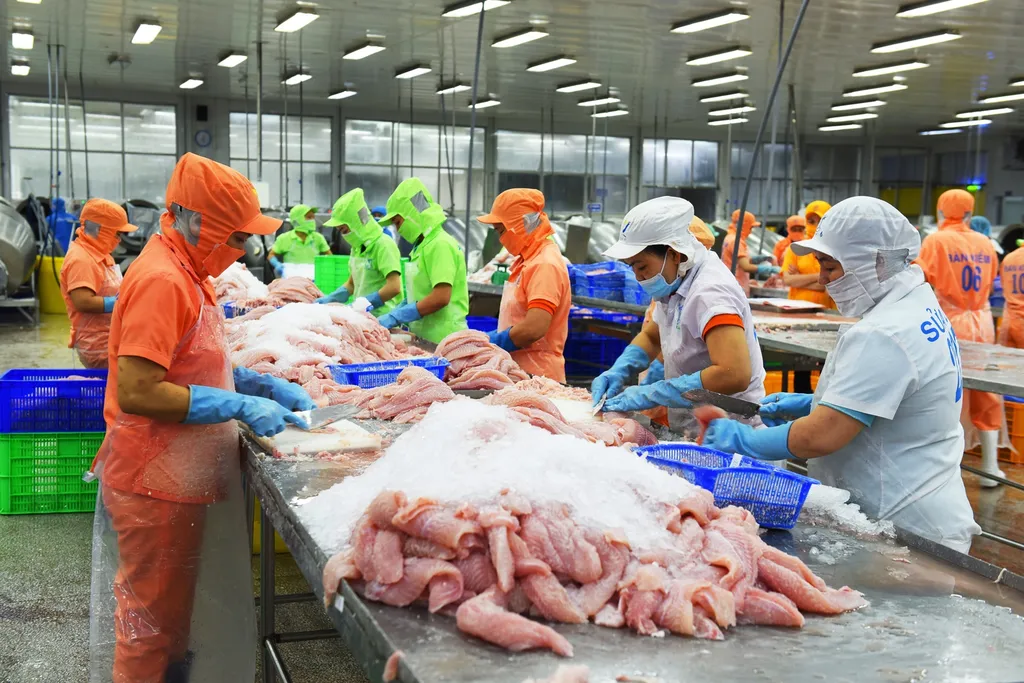 Economy
Economy

 |
| A tra catfish processing line for export at Hùng Cá JSC. In August, tra exports to the UK market increased three-fold over the same period last year, reaching over US$7 million. — VNA/VNS Photo Văn Trí |
{ "id": "fBXw2Cb5Oj", "type": "myToolImages", "data": { "data": "" } }
HÀ NỘI — Việt Nam's tra catfish exports to the UK are expected to reach US$67 million in 2022, increasing 30 per cent from last year, thanks to spectacular growth in recent months.
According to the Việt Nam Association of Seafood Exporters and Producers (VASEP), the UK is in the top 10 seafood import markets of Việt Nam, accounting for 3 per cent of seafood export value. In the first eight months of 2022, seafood exports to the UK increased by 3.5 per cent to $213 million. Of which, the tra exports to the market soared by 28 per cent to $47 million in the eight-month period. The frozen tra fillets accounted for 79 per cent, processed tra 17 per cent, and whole tra 4 per cent.
Alone in August, tra exports to the UK market increased three-fold over the same month last year, reaching over $7 million.
Inflation in the UK is at a 40-year record high and is almost the highest in European countries. The rising energy and raw materials costs are causing “heavy and lasting damage” to the fish-and-chip industry.
According to a recent survey of 410 members of the National Federation of Fish Friers (NFFF), gas and electricity prices have increased by 300-500 per cent. Europe's energy crisis worsened after Russia stopped the flow of gas via the Nord Stream 1 pipeline to the continent.
On September 5, the price of gas in the UK increased by 35 per cent, causing even more difficulties for fish-and-chip shops in the UK. They were put under great pressure when the prices of cod and haddock as well as other input costs such as potatoes and sunflower oil increased.
Therefore, the consumption of high-priced food items is limited. As a result, exports of shrimp, tuna and some marine fish species to the UK dropped sharply.
Meanwhile, tra exports still maintained growth because of the moderate price. Moreover, the UK has a shortage of white fish due to the seafood ban from Russia, making tra a substitute fish in the UK market.
VASEP forecast that with the current favourable growth momentum, tra exports to the UK in the remaining months of the year are showing more positive signs.
With preferential tariffs thanks to the UK – Việt Nam Free Trade Agreement (UKVFTA), Việt Nam's seafood exports to the UK continue to enjoy more incentives as tax on tra exports will be reduced to zero per cent after three years.
Ngô Chung Khanh, deputy head of the Multilateral Trade Policy Department under the Ministry of Industry and Trade (MoIT), told Việt Nam News that when exporting to the UK, Vietnamese enterprises may face high technical requirements on food hygiene and safety.
To take full advantage of the UKVFTA, seafood producers and exporters and the tra industry in particular need to actively prepare source of goods, improve competitiveness and production capacity as well as application of science and technology to increase the value of aquatic products.
“In particular, local enterprises need to voluntarily implement strict regulations on traceability; inspect and supervise the use of antibiotics in production and processing; quarantine aquatic products, ensure food safety and hygiene to have high-quality products, meeting the requirements of the importer,” he added.
It is also necessary for businesses to improve their social responsibility, paying attention to sustainable development issues mentioned in the UKVFTA and other new-generation free trade agreements, he added. — VNS